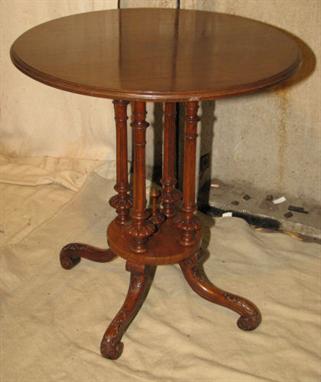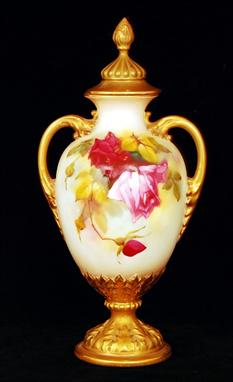We found 116099 price guide item(s) matching your search
There are 116099 lots that match your search criteria. Subscribe now to get instant access to the full price guide service.
Click here to subscribe- List
- Grid
-
116099 item(s)/page
A George IV silver lobed circular teapot by Rebecca Emes and Edward Barnard I, London 1825, with a flower finial, a leaf-capped loop handle and on a shaped circular pedestal, 25.5cm (10in) long; another conforming smaller by the same maker, 21.5cm (8.5in) long; and two similar cream jugs by Edward, Edward junior, John & William Barnard, London 1833, 1499g (48.2 oz) gross (extensive repairs to both teapots). Provenance: Cornwallis
An early Victorian silver gilt ogee small teapot, maker’s mark ‘W..’ (over punched), London 1842, with a flower finial to the scale and foliate scroll engraved flat coner, a leafy bifurcated twist handle, embossed with ribbon-tied flower and scroll reserves, engraved with a cypher ‘JC’ under a coronet, 18.5cm (7.25in) long, 388g (12.5 oz) gross. Provenance: Cornwallis
A George III silver baluster coffee pot by Thomas Wallis I, London 1780, with a flower finial, a later leaf-capped double handle (with rubbed additions marks) and later flower, scale and scroll work, the circular foot pierced, engraved with the crests of Mann and Cornwallis under a coronet, 24cm (9.5in) high, 830g (26.7 oz) gross (the finial unmarked). Provenance: Cornwallis
A silver straight-tapered three piece coffee service by Asprey & Co. Ltd, London 1970, the coffee pot with a turned finial, a conical cover, a scroll thumb piece, a wooden loop handle, cut-card spout and handle mount outlines and a moulded foot, 21cm (8.5in) high, 777g (25 oz) gross. Provenance: Cowdray
A matched pair of silver cafe au lait pots by Barker Bros. Ltd, Birmingham 1933 and 1937, slender ovoid with wooden ball finials and double scroll handles, trellis borders and flared bases, engraved ‘AC’ under a viscount’s coronet (for Anne Cowdray), 15.5cm (6.25in) high, 493g (15.85 oz) gross (one finial replaced). Provenance: Cowdray
A Victorian silver melon shaped tea pot by John Samuel Hunt (late Storr and Mortimer), London 1860, with a turned mushroom finial, a domed hinged flush cover, a leaf-capped loop handle and spout, on a shaped circular foot, engraved with the Courthope crest, 28cm (11in) long, 794g (25.5 oz) gross. Provenance: Courthope
An Edwardian silver baluster sugar caster by Robert & William Sorley, London 1902, in George I style, with a turned finial to the pierced and engraved domed cover, a central moulded girdle and a moulded circular foot, 20.5cm (8in) high; and a late Victorian ogee baluster sugar caster by Job Frank Hall, London 1898, embossed with vacant cartouches, foliage and decorative wrythen designs, on a circular foot, 20cm (8in) high, 516g (16.6 oz) gross. Provenance: Courthope
A George III silver oblong baluster tea pot by William Bennett, London 1807, with a composition finial and a harp handle, on four ball feet, 28cm (11in) long, 545g (17.5 oz) gross; and a late Victorian hotwater pot by Josiah Williams & Co. of Bristol, London 1898, with a spherical body, a shaped gadrooned rim and a composition finial and harp handle, on a collet foot, 15cm (6in) high, 399g (12.8 oz) gross. Provenance: Courthope
A late Victorian silver cruet stand by James Dixon & Sons, Sheffield 1899, on a shaped base with leaf-capped handle and feet, with wrythen borders, on trefoil feet, 23cm (9in) high, 664g (21.3 oz); another stand by Edward and John Barnard, London 1855, with a waisted oblong base engraved with the Courthope crest, on four scroll feet, 28cm (11in) high, 620g (20.5 oz), together with a silver mounted cut glass cruet bottle by the same maker, London 1854, with a turned bell finial and a bell shaped cover, engraved with the Courthope crest, 13.5cm (5.25in) high. Provenance: Courthope
A Victorian silver oval three piece tea service by John Chapple & John Mantell, London 1882, half fluted and engraved with an armorial, the tea pot with a composition finial and loop handle, 25.5cm (10in) long, 732g (23.55 oz) gross. Provenance: Berry. The shield recorded for LATHAM below two unrelated crests.
A silver straight-tapered coffee pot by William Hutton & Sons Ltd, Sheffield 1919, with a composition finial to the domed cover, a composition S-scroll handle and engraved with a crest, 20cm (8in) high; and a baluster milk jug by Wakely & Wheeler, London 1967, 14.5cm (5.75in) high, 779g (25 oz) gross. Provenance: Berry. The crest of BERRY as used by Lords Camrose and Hartwell.
[Horse racing interest] A 9 carat small twin handled trophy cup and cover by Tessiers Ltd (Arthur Martin Parsons & Frank Herbert Parsons), London 1922, with cut-card decoration to the cover and lower base, a coiled snake finial to the cable bordered cover, fancy double scroll handles and a cable band to the circular foot, later engraved ‘Cesarewitch 1978 won by Colonel Julian Berry’s Centurion’, 11.5cm (4.5in) high, 408g. Provenance: Berry. Lt. Col. Hon. Julian Berry, OBE, JP, DL (1920-1988) was the son of William Ewart Berry, 1st Viscount Camrose and Mary Agnes Corns and was educated at Eton. He married Janet Frances Denise Rowan-Thomson, daughter of Major John Leslie Rowan-Thomson, on 31 July 1946. He fought in the Second World War, later becoming Lieutenant-Colonel of the Royal Horse Guards between 1958 and 1960 and Colonel of the Household Cavalry and Silver Stick in Waiting in 1960. Centurion, a 3-year old, was ridden by John Matthias and trained by Ian Balding, starting price 9/2 Favourite.
A pair of unusual gilt metal, bronze and faux hardstone inset centrepieces, of North American interest, early 20th century, both with avine finial above a raised platform adorned with fish and crustacea, and gamebirds and fowl respectively, all arranged naturalistically and modelled as overspilling, with stop fluted and anthemia moulded undersides, on tapering, faceted, foliate cast and ‘bejewelled’ columns with Ionic capitals and maidens’ masks, descending to further tiers of birds and fish, each above a lizard curled around the top of a triform socle with shell, foliate and florally cast mounts to the sides, on silvered circular bases engraved with arabesques and mounted with three figures of native American tribespeople to one and four to the other, all in traditional dress and in naturalistic poses and attitudes, the bases each relief cast three times to the outer edges with the monogram FOP in relief with a crown above the cartouche, one insrcibed to the underside ‘Oiseaux’, the other also indistictly unsigned, 81cm high, 46cm wide. The use of Native American figures within the design of these centrepieces suggest a possible North American or French-Canadian connection. . The late 19th century saw a period of expansion resulting in the settlement of the Canadian West. During this period many North American artists and English Canadian sculptors as well, nostalgically incorporated Indians into thier work. An example of such is Louis-Philippe Hébert who is believed to have learnt his art from Napoleon Bourassa when they collaborated around 1870 on the Notre-Dame-de-Lourdes chapel in Montréal. Hébert was also influenced by the French realist tradition. His works included a number of bronze sculptures of Indians including the famous Pêcheur à la nigogue, which he produced for the legislative building in Québec City; the statue of Maisonneuve at Place d’Armes in Montréal; and his proud monument Madeleine de Verchères, located in the middle of the Québec village of Verchères. Emanuel Otto Hahn, a German sculptor who immigrated to Canada early in his life is noted for his Indian subjects. Alexander Phimister Proctor is also known for his use of Indian subjects although primarily for his use of animals.
A pair of Continental gilt bronze and white marble mounted pot pourri urns and covers, mid 19th century, each with berry cluster finial to a domed, foliate cast and openwork cover, the Campana urn bodies with acanthus and anthemion casting and openwork motifs, each with twin zoomorphic handles, on conforming waisted socles, the square section bases with beaded borders, 25cm high, 15.5cm wide. Provenance: Berry
A pair of cut glass and brass mounted three branch candelabra, possibly Baccarat, mid 19th century, each with knopped and faceted finial above a fluted, cut and further faceted central stem, above a foliate cast socle and domed base, the three sconces on faceted arms rising from conforming stems around the central one, hung overall with faceted glass beads and pendants, 51cm high, 29cm wide, (losses and damage). Provenance: Cornwallis
A pair of etched glass and brass mounted twin light girandoles in the 18th century taste, second half 20th century, the sockets and serpentine arms issuing from cartouche shaped backplates, etched with vases with floral sprays within borders, 38cm high, 27cm wide, 15cm protrudence; and a pair of moulded and cut glass twin light wall appliques in the George III style, 20th century, each with an obelisk finial and spherical terminal, 54cm high overall, approximately 32cm wide
A Royal Worcester vase and cover, shape 2026, of footed ovoid form with applied loop handle,s shallow neck and domed finial mounted cover decorated by Kitty Blake with large rose blooms between gilded borders, signed to the body, printed marks and date code for 1926, height 25 cm. ILLUSTRATED
A Royal Worcester vase and cover, shape 2026, of footed ovoid form with applied loop handle,s shallow neck and domed finial mounted cover decorated by E.S. Pilsbury with large rose blooms between gilded borders, signed to the body, printed marks and date code for 1926, height 25 cm, S/D to the cover. ILLUSTRATED
A Royal Worcester Ariosto Inkwell in the Henry Deaux style of compressed ovoid form relief moulded with face masks and set to the backs of classical maidens with a lions paw foot all to a triform base below a finial set with a cherub, the whole picked out in Raphaelesque colours, printed mark and date code for 1862, height 14.5 cm. ILLUSTRATED
A large Royal Worcester vase and cover, shape 2299, of footed shouldered ovoid form with flying scroll handles, drawn collar neck and a finial mounted cover, decorated by W.E, Jarman with large rose blooms within graduated green and gilded borders, unsigned to the body, printed marks and date code for 1906, height 23 cm, minor restoration to the finial. ILLUSTRATED
A George III mahogany long case clock, the eight-day movement with automata in the form of a warship at sail. With twin scroll pediment and three brass finials above the 13" broken arch dial with silvered chapter ring, subsidiary seconds dial and date aperture, signed D. Seddon, Frodsham. The trunk of the case with pilaster supports above bracket feet, 60cm wide by 240cm high (to top of finial). ILLUSTRATED
-
116099 item(s)/page


















![[Horse racing interest] A 9 carat small twin handled trophy cup and cover by Tessiers Ltd (Arthur Martin Parsons & Frank](http://lot-images.atgmedia.com/SR/10011/2799870/346-2010825105956_468x382.jpg)






































